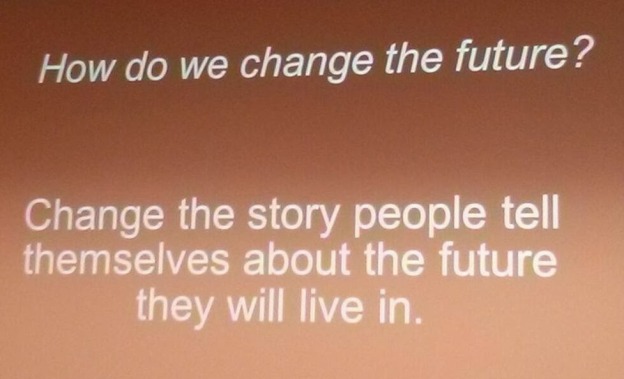Last week I spoke on a panel at a World Financial Symposium event in Seattle. I arrived a little early and was rewarded with a great talk by Brian David Johnson, a “futurist” at Intel.
Johnson had interesting things to say about both the process of “futurecasting” and a few of his specific predictions, but the idea that stuck with me was his closer (I took a photo of the slide to make sure I got it right):
Q: How do we change the future?
A: Change the story people tell themselves about the future they will live in.
This deceptively simple statement captures a fundamental truth about leadership — whether as a parent, as a manager, or as a community advocate:
Consistent, positive actions spring from a coherent sense of identity — a self-reinforcing set of internal narratives about how people like this behave in circumstances like that.
For kids, these shards of identity most often describe the self, as in: “I’m the kind of person who…” “…doesn’t give up easily”, or, “…is good at soccer”, or, “…likes to travel”.
For companies, the most productive narratives are generally those that describe the role the company aspires to play in its customers’ lives, with a structure like: “We make it easy for our customers to… save for retirement”, or, “… manage a complex sales process”, or “… shop for a new car”.
For communities, the most powerful narratives are often about the values and activities that the community comes together to accomplish, as in: “We’re a community that … supports entrepreneurship”, or, “… invests in its schools”, or, “… embraces diversity”.
Seen through this lens, effective leadership is made up of of just two core disciplines:
- Forging plausible, inspiring stories about the future we wish for ourselves, our families, our companies or our communities, and
- Sharing those stories with people in a way that allows them both to embrace them, and to make them their own.

